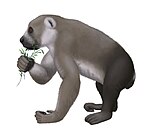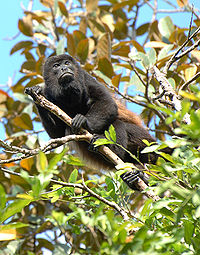Portal:Primates
The Primates Portal A primate is a member of the biological order Primates, the group that contains lemurs, the aye-aye, lorisids, galagos, tarsiers, monkeys, and apes, with the last category including great apes. With the exception of humans, who inhabit every continent on Earth, most primates live in tropical or subtropical regions of the Americas, Africa and Asia. Primates range in size from the 30-gram (1 oz) pygmy mouse lemur to the 200-kilogram (440 lb) mountain gorilla. According to fossil evidence, the primitive ancestors of primates may have existed in the late Cretaceous period around 65 mya (million years ago), and the oldest known primate is the Late Paleocene Plesiadapis, c. 55–58 mya. Molecular clock studies suggest that the primate branch may be even older, originating in the mid-Cretaceous period around 85 mya. Primates exhibit a wide range of characteristics. Some primates do not live primarily in trees, but all species possess adaptations for climbing trees. Locomotion techniques used include leaping from tree to tree, walking on two or four limbs, knuckle-walking, and swinging between branches of trees (known as brachiation). Primates are characterized by their large brains relative to other mammals. These features are most significant in monkeys and apes, and noticeably less so in lorises and lemurs. Many species are sexually dimorphic, which means males and females have different physical traits, including body mass, canine tooth size, and coloration.
Selected article
Archaeoindris fontoynontii is an extinct, giant lemur and the largest primate known to have evolved on Madagascar, comparable in size to a male gorilla. It belonged to a family of extinct lemurs known as "sloth lemurs" (Palaeopropithecidae), and because of its extremely large size, it has been compared to the extinct ground sloths of North and South America. It was most closely related to Palaeopropithecus, the second largest type of sloth lemur. Along with the other extinct sloth lemurs, Archaeoindris was related to the living indri, sifakas, and woolly lemurs, as well as the recently extinct monkey lemurs (Archaeolemuridae). It probably became extinct recently, around 350 BCE.
Its remains have been found at only one location: Ampasambazimba, a subfossil site in central Madagascar. The skeleton of Archaeoindris was massive and robust, and shared many traits with that of Palaeopropithecus. The arms were longer than the legs, but no hand or foot bones have been found for comparison with the other sloth lemurs. Size estimates based on the limited remains have varied widely, ranging as high as 244.1 kg (538 lb), but the most thorough statistical investigation estimates a mass of 160 kg (350 lb). There are varying opinions about the way Archaeoindris moved in its environment, ranging from tree-dwelling to ground-dwelling. Its skeleton suggests it was a deliberate climber that visited the ground to travel. The diet of Archaeoindris was mostly leaves, and its habitat—prior to human arrival—was a mix of woodlands, bushlands, and savanna, rich in lemur diversity. Although it was a rare lemur, it was still extant when humans first arrived on Madagascar, and it would have been vulnerable to hunting and habitat loss. Selected picture The ring-tailed lemur (Lemur catta) is a large strepsirrhine primate and the most recognized lemur due to its long, black and white ringed tail. It belongs to Lemuridae, one of five lemur families, and is the only member of the Lemur genus. Like all lemurs it is endemic to the island of Madagascar. Known locally in Malagasy as maky (spelled maki in French) or hira, it inhabits gallery forests to spiny scrub in the southern regions of the island. It is omnivorous and the most terrestrial of lemurs. The animal is diurnal, being active exclusively in daylight hours. CategoriesSelected species Least Concern (IUCN 3.1)|Least Concern The mantled howler (Alouatta palliata), or golden-mantled howling monkey, is a species of howler monkey, a type of New World monkey, from Central and South America. It is one of the monkey species most often seen and heard in the wild in Central America. It takes its "mantled" name from the long guard hairs on its sides. The mantled howler is one of the largest Central American monkeys, and males can weigh up to 9.8 kg (22 lb). It is the one Central American monkey whose diet is composed mostly of leaves. The mantled howler has several adaptations to this folivorous diet. Since leaves are difficult to digest and provide less energy than most foods, mantled howlers spend the majority of each day resting and sleeping. Male mantled howlers also have an enlarged hyoid bone, which is a hollow bone near the vocal cords. This enlarged bone amplifies the calls made by the male, which give the monkey its common name of "howler". Howling allows the monkeys to locate each other without expending energy on moving or risking physical confrontation. Did you know?
Primate lists
WikiProjectsThings to do
Associated WikimediaDiscover Wikipedia using portals |

















